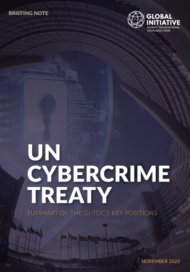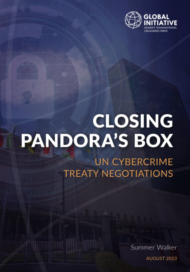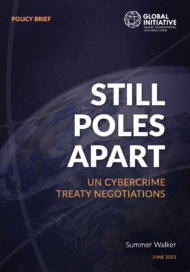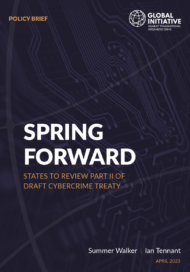Posted on 15 Feb 2024
While supporters of the UN’s cybercrime treaty have seen their dreams deferred with the convention’s postponement, those concerned about the treaty’s potential impact on human rights and freedoms are breathing a momentary sigh of relief.
After two years of negotiations, state representatives gathered in New York from 29 January to 9 February 2024 for the concluding session of the Ad Hoc Committee (AHC) to Elaborate a Comprehensive International Convention on Countering the Use of Information and Communications Technologies for Criminal Purposes (or a ‘cybercrime convention’). Despite the long journey to this point, member states were unable to overcome the fundamental sticking points over what form a UN cybercrime convention should take: whether it should be a traditional cybercrime treaty or a broader treaty covering all crimes committed using information and communications technologies. Instead of honouring the committee’s mandate to vote on the different options, member states ultimately chose to postpone the decision until a later date.
A lack of consensus among delegations has characterized the process since it began, including at the penultimate session in August 2023, when the committee ended with a small minority of peripheral provisions agreed in a draft presented by the Chair. The final session in New York arrived without visible signs of progress, and it was difficult to predict what the outcome would be.
By the end of the session, the reality of the political issues and the disagreement on the text of the treaty in the major areas of polarization (i.e. the scope of international cooperation and the extent of human rights safeguards) proved too difficult to resolve in the time available to the committee. The committee ultimately decided to suspend the session and reconvene later this year (subject to UN General Assembly approval and resources).
For some, this has meant that the hope of adopting the first global and universal convention to combat cybercrime (with different objectives) has been deferred. For others, it was an opportunity to pause the discussions and reflect on what the expected outcome of a universally binding treaty should be. But many who followed the process with alarm breathed a sigh of relief that what could so easily become a tool of oppression was not adopted by the UN.
A snail’s pace
In order to try to ensure progress on the main areas of disagreement, the Chair’s working method was to divide the discussion into two tracks (the plenary and open-ended informal sessions) held in parallel. While discussions in the plenary focused on less controversial issues, delegates worked behind closed doors in informals to resolve the most sensitive matters relating to the scope of the convention, as well as provisions on human rights and legal safeguards. The full-speed approach of the plenary, coupled with the backstage nature of the more substantive discussions, deprived multi-stakeholder observers of opportunities to contribute. This marked an uncomfortable departure from previous AHC meetings.
While the plenary discussions may have felt rushed, the committee was running behind schedule and under pressure to consider the full breadth of the draft as the first week of the final session drew to a close. Despite the time constraints, by the beginning of the second week, member states were still debating the name of the convention and had begun discussing a draft resolution to be considered by the UN General Assembly (to accompany the convention through its approval process at the General Assembly), even before returning to the actual content of the convention.
A change in the pace and nature of the discussions did not occur until the end of the second week, when member states entered the plenary to discuss the Chair’s compromise package (i.e. provisions on the core issues on which member states had not yet reached agreement).
Human rights safeguards: a pending issue
One of the most contentious issues, human rights (Article 5) and safeguards (Article 24), ultimately failed to find consensus during the session and remained in the Chair’s package proposals until the end of the meeting. From the outset of day 1 of the negotiations, some member states (including Iran) did not want any explicit reference to human rights in the treaty, arguing that the cybercrime treaty was not a human rights treaty and that a similar approach to the UN Convention against Corruption (UNCAC) should be taken (i.e. no reference to human rights included). This position was opposed by a wide range of member states, including Western countries and some countries in Latin America, Asia and Africa.
The treaty’s potentially unprecedented impact on human rights (including the right to privacy and freedom of expression) was a key concern of civil society, and was well documented and advocated by multi-stakeholder participants throughout the session.
Scope of international cooperation: New Zealand’s proposal
Related to the protection of human rights is the scope of cooperation on electronic evidence to be included in the treaty, on which no consensus was reached.
One of the options before the committee is a broader scope for cooperation on electronic evidence, including for ‘serious crimes’ in general, which could be combined with a narrow criminalization chapter and some kind of agreement on how other crimes could be added to the convention in the future. Extending the scope of cooperation on electronic evidence to a wider and undefined set of crimes may pose inherent human rights risks.
The compromise presented in the Chair’s package includes Article 59(3), which partly reflects Canada’s widely supported proposal to clarify Article 3 on scope and to avoid any misinterpretation of the treaty that would be inconsistent with the broader obligations and responsibilities of member states. Canada’s proposal was a welcome call to respect human rights and a reminder of the risks that this treaty poses to civil society actors. As member states could not agree on the language, a suggestion that seemed to gain traction (even with some ‘middle ground’ states) was the inclusion of an Article 40, paragraph 20 bis, mirroring New Zealand’s proposal for Article 37(15) – a non-discrimination clause for grounds of refusal. The advantage of this provision would be that the grounds for refusal would apply to the whole chapter on international co-operation.
Criminalization chapter: a wide range of uncertainty
The debates on the criminalization chapter centred on whether it should include a wider range of crimes or whether it should be narrower – a familiar dividing line in the AHC. In this respect, two provisions are still in play. One is Article 60 of the Chair’s package, which creates an obligation for member states to criminalize offences established in accordance with UN conventions and protocols if committed using information and communications technologies. This provision would make it mandatory for member states to criminalize offences such as arms trafficking, drug trafficking and human trafficking if committed online, without providing any guidance on how this should be done.
Another relevant article here, proposed by the Russian Federation, is Article 5bis of the draft resolution presented to the committee. The idea behind this provision is that a protocol addressing additional forms of crimes and relevant mechanisms, consistent with the scope and implementation of the convention, could be the subject of future negotiations by an extended AHC in the next year and a half (i.e. before this treaty potentially enters into force). This provision could also have the potential to expand the criminalization chapter.
Two key provisions of this chapter seemed to be heading nowhere towards consensus – namely, the articles on online sexual abuse (Article 13) and non-consensual distribution of intimate images (Article 15). The importance of protecting children is undeniable, but one of the most challenging crossroads faced by delegates was how to incorporate more progressive language to ensure the protection of privacy without the risk of over-criminalizing children and adolescents who engage in consensual sexual activity.
The final scene
When the Chair presented the further revised draft (excluding the articles included in the compromise package) to the plenary, some might have expected the reading to be more straightforward. However, the final day’s proceedings highlighted the continuing disagreements – often exposing the different cultural and social values that countries bring to these negotiations. At this stage, there was simply not enough time or political bandwidth left to make the major compromises.
On the last morning of the AHC, delegates already knew that the decision time would be delayed, which led to a more relaxed atmosphere in the room after two weeks of intense talks. After hearing outstanding statements from member states on chapters 5–9 in the morning meeting – including a proposal from Mexico to increase to 60 the number of member state signatures required for the convention to enter into force – the AHC agreed to suspend the session and postpone the final decision.
As the secretariat mentioned, the draft decision submitted by the committee to the General Assembly has ‘programme budget implications’, meaning that the UN will have to pay for it somehow, as well as find a venue and a suitable time. Given the UN’s current liquidity crisis, and with each AHC meeting estimated to cost at least US$1million, it remains to be seen how the General Assembly and the ‘5th Committee’ of delegates dealing with the budget will react. The response will, of course, reflect the level of political importance that states attach to the process.
Liechtenstein also noted that postponing the negotiations was a difficult decision for small states with limited resources, and that the renewed extension has affected its ability to continue to cover the process. There are likely to be many other states in a similar situation, who will need to consider carefully how much more they can commit.
After two years, the main question remains the same: is this a focused cybercrime treaty or a broader instrument to criminalize and facilitate international cooperation on a wide range of crimes? As it stands, the treaty is still a confusing mix of both, and perhaps that is why it has been so difficult for member states to reach consensus. Even if member states get closer to compromising on the basics and agree on a ‘package deal’, there is still much fear about the negative impact the treaty could have on rights and safety online.
See our Cyber Convention Check-in for a full overview and daily coverage of the final session.
Sign up to our UN engagement mailing list to receive regular updates from the UNTOC-Watch team



